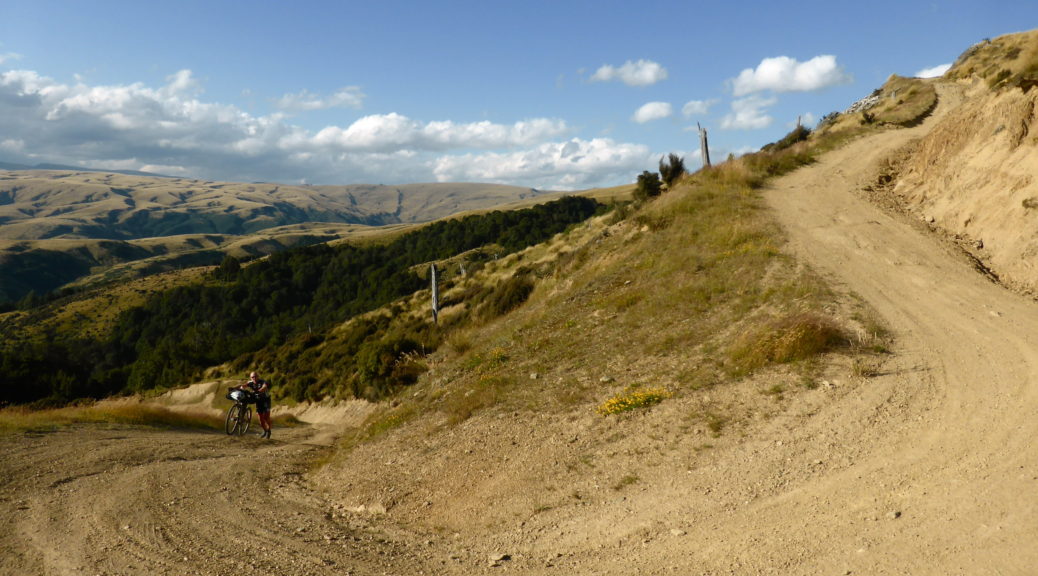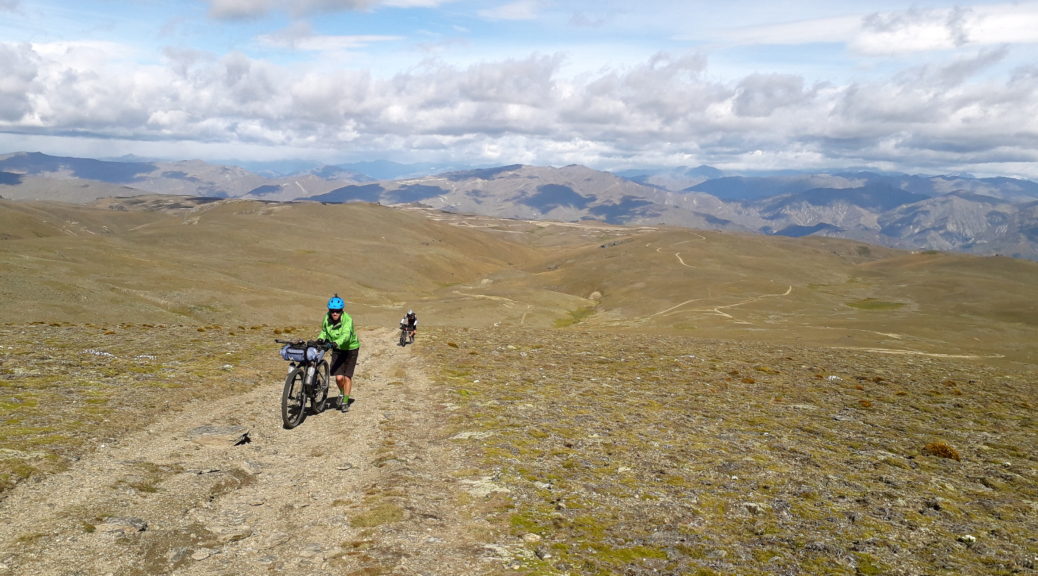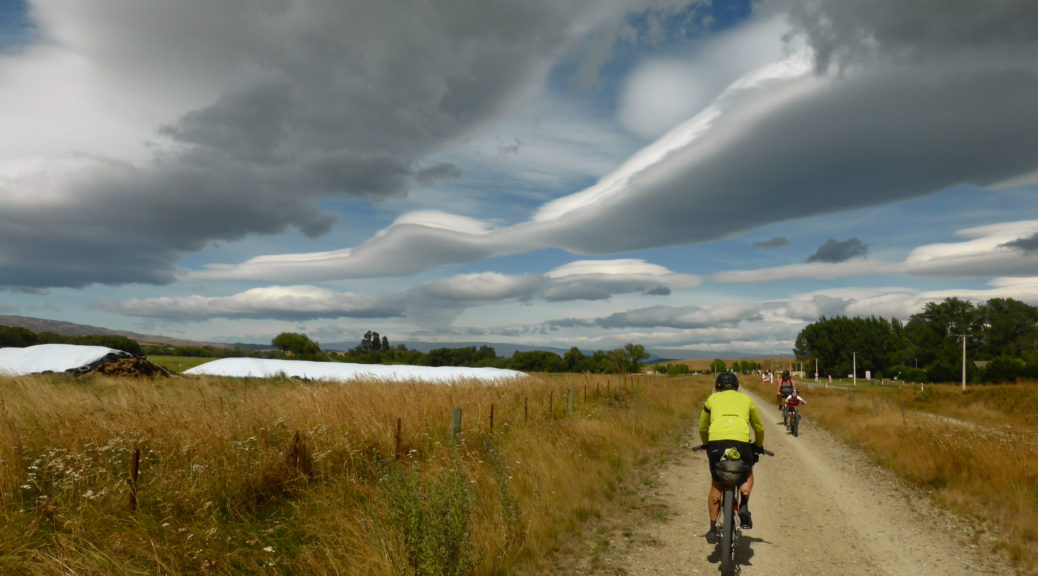Overnight the wind was fierce and harried the old hut’s very structure. Kept awake most of the night by the corrugated iron responding to every fresh gust, I was convinced that we wouldn’t be able to stand – let alone ride – outside in the storm; this would mean holing up in the hut until the storm abated. Of course, conditions imagined were worse than actual conditions – but not by much!
Away by five o’clock, the wind did at least push us up the altitude we’d lost detouring to the building. Passing an even more dilapidated hut, our route turned us north following the ridge line. Our helpful tailwind turned into a pummeling crosswind – which one began to expect after three days of such conditions. Intermittently the route was steep, but mostly it was a good surface to ride on.
We made painfully slow progress constantly fighting the wind. With my slight frame, I was mostly pushing my bike. Occasionally I’d try to ride, but due to self-preservation that was usually short-lived. Jake and Steve, being much better built, could ride more and I was often lagging at the back making steady, albeit incremental, progress. The views were fantastic, as it was a clear day. Unfortunately, I never stopped to get my camera out – the risk of my bike, or me, blowing away if we separated was ever present.
Memories of the ridge top are pushing my bike, trying to hold onto my bike, being blown off my bike, watching the others try to ride leaning right into the wind, and most of all staring incredulously at Jake being hit by yet another gust and blown sideways into a fence! The last few metres up to the high point at the Oblesik were by far the hardest. It took all my strength (admittedly that’s not a lot if I’m not pedaling) to inch forward holding onto my bike. At times, the wind would come and kick the back wheel around again; but that was nothing to having both wheels whipped off the ground and suddenly I was holding onto my handlebars and seat watching as my loaded bike started to fly like a kite, completely horizontal. Surreal.
Somehow, I managed to hold on and make it inch by inch to the shelter of the big rock. We rested and ate for some time out of the wind. Twenty kilometres had taken three hours! Fed and slightly rested, I got up and carried on. The wind was strongest being forced around the big rock – walking, I was promptly blown over as I toppled on top of my bike and onto the ground.
After another couple of miles of effort, we gradually turned from the wind and started the descent off the range. Things got slightly easier, I could even ride my bike! The downhill was hard work, but much more preferable to being on the ridge. Reaching a road, it was a steep drop down to the Clutha valley floor. The road seemed pretty minor and doesn’t really go anywhere, so the vast resealing work and fleet of trucks hauling chip up the steep hill were rather incongruous. It started to warm up off the mountain, we stopped to de-layer, Jake returned a bottle of mine that shaken itself loose and realised he had very worn brake-pads.
Finally we had the wind at our back as we hit roads and trails familiar to me that took us into Alexandra. A bike shop was found, I replaced my dark safety glasses and we restocked with supplies for the next day of riding. Finally, we sat and devoured a large and well-earned brunch. More familiar trails, and another convenience store stop, took us out of town. Now the wind really was at our backs!
A bit of the rail trail and then we were on the Old Dunstan Road – that used by the mid-nineteenth century gold miners to get from Dunedin to Dunstan (now Clyde) in the summer. I was well aware there was stunning scenery linked by gravel roads and not inconsiderable climbing as I’d ridden this a year before with Adele. Just as well I took plenty of photos that time. Over Crawford Hills, crossing a water race we dropped into the upper reaches of the Ida Valley before making the long steady climb up to Poolburn Reservoir. The three of us were getting pretty sleepy in the mid-afternoon sunshine, so we found a shut-up hut and napped for half an hour on the paving stones out of the wind.
 From our napping vantage point, Poolburn Reservoir.
From our napping vantage point, Poolburn Reservoir.
We had plenty more climbing to do, so somewhat rejuvenated we passed the dam and continued the climbing up to 1000 m. Nearing the top, the forecast southerly change caught up with us and we were hit full in the face with wind, rain and then sleet. It was suddenly cold and all our layers went on.
The gravel road turned to farm track as we were pelted with freezing rain and sleet. While it was nice to be going down, one couldn’t go too fast due to the conditions. Also, there were quite a few gates to stop for. We leap-frogged a small convoy of freedom-camping young Europeans in their vans. Steve was looking pretty cold and close to exposure, I was wet but comfortable enough and Jake was probably the best prepared for such adverse weather. Reaching gravel again we began to look for shelter.
I knew the steep climbing to come and there was no way I was going up, cold and wet, over 1000 m again and into probable snow. Consensus was reached, and a shack was spotted at Linnburn as I sailed past. Thankfully the beehives adjacent to it were dormant and we entered well pleased to be out of the rain and cold. A long-abandoned two-room dwelling, we set about getting warm and dry, trying to plug the gaps in the walls and windows, and waiting out the storm.
 It was a house to us.
It was a house to us.
Only a twelve-hour day of riding (in the loosest sense of the word really) was brought to an end. Strangely, the sun did come out briefly before dusk; but it would have taken a lot to get my up on the tops again that night. Quite an exciting and satisfying day to make it through, I was exhausted and happy to drift in and out of fitful sleep for ten warm hours. Four days in a row I’d been blown off my bike, that’s a whole new level of windiness.

 The valley narrowed and the grade increased slightly.
The valley narrowed and the grade increased slightly. Pointing the front wheel down, soon I was past the historic Garston Ski Hut – making a note to return here with a beefier mountain bike and explore further.
Pointing the front wheel down, soon I was past the historic Garston Ski Hut – making a note to return here with a beefier mountain bike and explore further. There was over seven hundred metres to lose plunging down the exhilarating gravel to the Mataura valley floor. Reacquainting myself with the fierce norwester, I was slowed a little.
There was over seven hundred metres to lose plunging down the exhilarating gravel to the Mataura valley floor. Reacquainting myself with the fierce norwester, I was slowed a little.  Snaking down the hills took me to a short stretch of highway and onto Garston (apparently the most-inland settlement in New Zealand; who knew?).
Snaking down the hills took me to a short stretch of highway and onto Garston (apparently the most-inland settlement in New Zealand; who knew?).

 More trail angels! I hardly knew where I was in the country, but there was an invitation to come to the farmhouse for tea. I don’t know how I passed that up, the goodies in the box probably helped.
More trail angels! I hardly knew where I was in the country, but there was an invitation to come to the farmhouse for tea. I don’t know how I passed that up, the goodies in the box probably helped. After lovely riverside riding for some time, we entered dense native forest and the steep undulating climbs and descents began.
After lovely riverside riding for some time, we entered dense native forest and the steep undulating climbs and descents began. As the afternoon drew to a close there was now not excessive heat in the wind.
As the afternoon drew to a close there was now not excessive heat in the wind. It flattened out, a bit, and was rideable in parts.
It flattened out, a bit, and was rideable in parts. It was hard to believe this was once a gold mining settlement of 150 hardy people. It was fierce enough up here on a clear summer’s night; winter must have been something else.
It was hard to believe this was once a gold mining settlement of 150 hardy people. It was fierce enough up here on a clear summer’s night; winter must have been something else. A slightly newer hut sheltered us for the night.
A slightly newer hut sheltered us for the night. Happy to not be trying to sleep in my bivy bag, the smell of the mattresses was best ignored.
Happy to not be trying to sleep in my bivy bag, the smell of the mattresses was best ignored.
 Quickly I was overlooking the valley below as the sun hit the hills opposite.
Quickly I was overlooking the valley below as the sun hit the hills opposite. I was pleased to be doing this climb in the cool and shade of the early morning.
I was pleased to be doing this climb in the cool and shade of the early morning. The hut appeared soon enough and seemed a good spot for a snack and brief pause.
The hut appeared soon enough and seemed a good spot for a snack and brief pause. Kirtle Burn Hut was out of the slight valley the creek was in. I didn’t stop long, as the wind had really picked up.
Kirtle Burn Hut was out of the slight valley the creek was in. I didn’t stop long, as the wind had really picked up. A zig left and then a zag right and we were definitely on the shoulder riding up through barren rocks.
A zig left and then a zag right and we were definitely on the shoulder riding up through barren rocks. Before long, it was too steep and windy to ride.
Before long, it was too steep and windy to ride. The last time I bothered to take a photo – it was a long push up that slope from Sally’s Pinch into the wind.
The last time I bothered to take a photo – it was a long push up that slope from Sally’s Pinch into the wind. Back to Wanaka – six hours of effort didn’t seem to have got me as far as usual!
Back to Wanaka – six hours of effort didn’t seem to have got me as far as usual! Eventually I could ride again. There was much rejoicing.
Eventually I could ride again. There was much rejoicing. These flowers looked an invasive species, but they sure were pretty.
These flowers looked an invasive species, but they sure were pretty. Even at my pace, I ended up chasing much of this herd up the road as one by one they peeled off.
Even at my pace, I ended up chasing much of this herd up the road as one by one they peeled off. Eventually, I was no longer herding cattle up the road.
Eventually, I was no longer herding cattle up the road. Back towards Cromwell and Lake Dunstan.
Back towards Cromwell and Lake Dunstan. It was quite a fun drop down into the valley – I’m sure nothing to do with my legs not having to do anything.
It was quite a fun drop down into the valley – I’m sure nothing to do with my legs not having to do anything. Home for the night, wonderfully sheltered from the wind by the caravan.
Home for the night, wonderfully sheltered from the wind by the caravan.
 The sun started to hit the basin from which I’d steeply left – the track across the bottom of the frame.
The sun started to hit the basin from which I’d steeply left – the track across the bottom of the frame. Finally, the high point came into view and I crossed from Canterbury to Otago.
Finally, the high point came into view and I crossed from Canterbury to Otago. Things flattened out and opened up a bit and we joined the eastern branch of the Manuherikia River.
Things flattened out and opened up a bit and we joined the eastern branch of the Manuherikia River.  The bridge over the river had long since been washed out, but picking the right spot it was easy enough to ride through.
The bridge over the river had long since been washed out, but picking the right spot it was easy enough to ride through. Looking over the overflow intake to the Hawkdun Range, our route enters the frame from the left.
Looking over the overflow intake to the Hawkdun Range, our route enters the frame from the left. Admiring the clouds as we headed into Lauder.
Admiring the clouds as we headed into Lauder.
 First trail angel! Delicious cookies left out for GSB riders just before Albertown.
First trail angel! Delicious cookies left out for GSB riders just before Albertown.